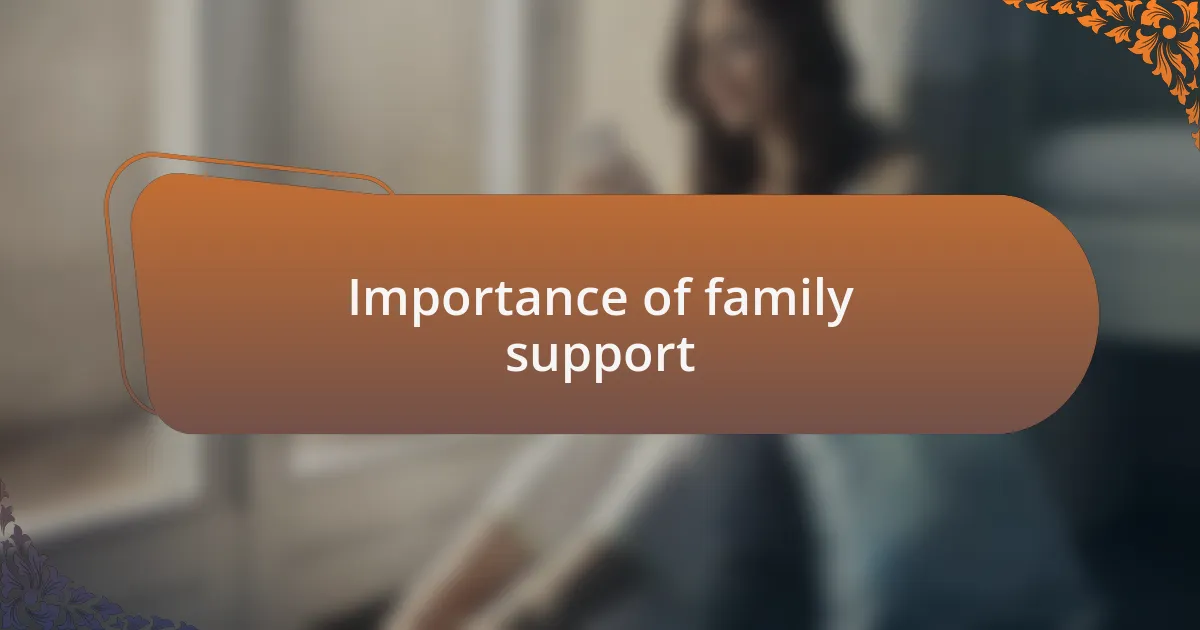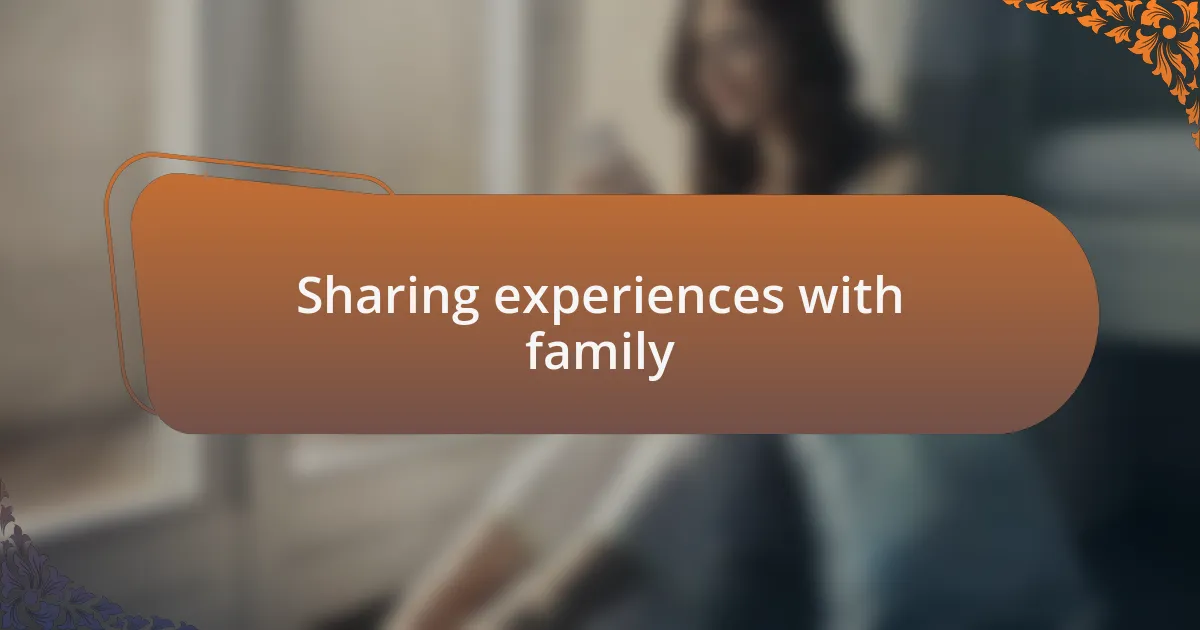Key takeaways:
- Selective mutism is an anxiety disorder affecting children’s ability to speak in specific social situations, leading to feelings of isolation and anxiety.
- Family support is crucial in helping children navigate selective mutism, as understanding and patience can create a safe environment for communication.
- Effective preparation for family gatherings, such as discussing expectations and providing a “safe person,” can significantly reduce anxiety for children with selective mutism.
- Sharing experiences and fostering open communication within families strengthens bonds and promotes a supportive atmosphere for those facing the challenges of selective mutism.

Understanding selective mutism
Selective mutism is an anxiety disorder primarily affecting children, where they struggle to speak in specific social situations despite being able to communicate comfortably in familiar settings, such as at home. I remember a family gathering when my niece, who has selective mutism, sat quietly in the corner, her eyes darting around the room while her cousins laughed and played. It’s heartbreaking to see a child want to join in but feel paralyzed by fear.
This condition often goes unnoticed or misunderstood, which can be frustrating for families encountering it for the first time. I still recall the moment when relatives expressed concern, questioning my niece’s shyness, unaware that her silence was much more complex. Have you ever felt trapped in your own world, unable to express yourself? That’s the reality for many children with selective mutism—they are often bursting with thoughts but struggle to share them in unfamiliar environments.
Interventions typically focus on building confidence and reducing anxiety, which requires a thoughtful approach. I’ve seen positive outcomes when gentle encouragement and understanding are applied consistently, allowing children to find their voice at their own pace. It’s crucial to recognize that behind the silence is a vibrant mind waiting to be heard, reminding us that sometimes, understanding begins with patience and love.

Effects of selective mutism
The effects of selective mutism can ripple through both the individual and their family dynamics. For instance, I once witnessed how my best friend’s daughter, although capable of expressing herself freely at home, withdrew from a cousin’s birthday party, leading to a palpable tension between her and the other children. It made me realize how isolating this disorder can be—not just for the child but for everyone around them who is eager to engage.
Emotionally, in my experience, children with selective mutism often carry an invisible weight of anxiety that can manifest as frustration, sadness, or even anger. I remember a poignant moment when my niece, after a joyful day at the park, burst into tears at the mere thought of attending a family dinner. She craved connection but grappled with a profound fear of being judged. It’s hard not to feel heartbroken in such moments—how do we help them when every attempt to communicate feels like a monumental hurdle?
Socially, the effects can extend beyond the immediate family. In a community where children are expected to interact, those with selective mutism may find themselves marginalized. I’ve seen my sister grapple with this as she explained to friends that her daughter isn’t unfriendly; rather, she’s trying to navigate a world that seems daunting. It’s a reminder that understanding and compassion can transform these difficult situations into chances for connection. How do we cultivate an environment that allows these children to shine, even when their voices are quiet?

Importance of family support
Family support plays a crucial role in helping children with selective mutism feel understood and accepted. I recall a family gathering where my cousin’s son experienced a wave of anxiety as soon as he entered the room full of relatives. His parents, noticing his distress, gently guided him to a quieter corner where they could engage with him one-on-one. This small act of support empowered him to eventually join the larger group, highlighting how a supportive environment can make a significant difference.
I’ve observed that when families actively advocate for their child’s needs, it fosters a sense of security that eases their fears. For example, my aunt routinely emphasizes to all family members the importance of patience and understanding when interacting with her daughter, which has led to more meaningful connections. It’s fascinating to see how simply educating family members can change the dynamics entirely, making it less about the child’s silence and more about the relationships they can build, even in quiet ways.
Without that unwavering family backing, children often feel isolated, as they navigate a world filled with unspoken challenges. I remember another instance where my friend’s daughter felt overwhelmed during a holiday dinner. Her family surrounded her with encouragement, letting her know it was perfectly okay to take breaks and express her feelings. This approach reassured her that she wasn’t alone, sparking conversations about her experiences and affirming the belief that support can transform daunting situations into opportunities for connection. How important is it for families to be champions for their loved ones in these moments, allowing them to step out of their shells?

Preparing for family gatherings
Preparing for family gatherings can be a delicate process, especially for children with selective mutism. When I prepare my child for such events, I make it a point to share what to expect. We talk about the relatives they might see and explore potential conversations they may have, which helps to demystify the situation. Does this sound like a lot? Maybe, but I find that a little bit of preparation goes a long way in reducing anxiety.
I also encourage my child to have a “safe person” at the gathering. This could be a trusted family member who understands their needs. I remember at last year’s family reunion, my sister stood by my child’s side during the initial chaos. Just having her nearby allowed my child to feel a sense of control and comfort. Without that familiarity, it could have felt overwhelming.
Another essential step is to plan for breaks during the gathering. I’ve learned that taking time out can help recharge my child’s emotional batteries. For instance, we created a calm corner in the living room with a few comforting items. This little space made a huge difference when my child needed to step away from the crowd. Have you tried establishing a quiet zone at family gatherings? It truly can be a game-changer for maintaining emotional resilience.

Strategies for effective communication
Effective communication in family gatherings is crucial, especially for children with selective mutism. One strategy I’ve employed is using visual aids, like picture cards, to facilitate conversations. These cards allow my child to express their thoughts without the pressure of verbal communication. Have you ever considered how simple images could bridge a complex gap?
In family settings, I’ve found role-playing potential interactions at home can be incredibly valuable. For instance, we practice simple greetings and pleasantries, making these exchanges feel less daunting when faced with real relatives. I’ll never forget when my child confidently greeted their aunt during last year’s Thanksgiving dinner, thanks to our practice sessions. It was a proud moment, illustrating how preparation translates into confidence.
Another method I’ve adopted is incorporating technology. Using a voice recorder, my child can record their thoughts or even quirky family jokes to share later. This approach allows them to participate in the celebration on their terms, providing a sense of inclusion. Have you thought about leveraging technology to empower your child’s voice? It’s truly fascinating to see how these small adjustments can foster deeper connections within our families.

Coping with anxiety triggers
Coping with anxiety triggers can be a delicate dance, especially in packed family gatherings. I remember one event where my child was overwhelmed by the sound of laughter and chatter echoing in every corner. To address this, I brought noise-canceling headphones to help create a comforting bubble, allowing them to still engage while minimizing overwhelming stimuli. Have you considered how sound can significantly affect your child’s comfort level?
Finding a quiet space is another essential strategy I’ve discovered. At one family reunion, we found an unoccupied room where my child could take a breather. Just stepping away from the high-energy atmosphere was a game-changer—it recharged their spirits and made it easier to re-enter the festivities when they felt ready. Does this resonate with your experience?
I’ve also learned the value of breathing exercises. One memorable moment was when we practiced deep breathing techniques just before mingling with relatives. My child took a few slow, intentional breaths, and you could almost see the tension release. I felt such relief knowing we had those tools to manage anxiety triggers in real-time. What calming techniques could you introduce to help your child navigate similar situations?

Sharing experiences with family
Sharing experiences with family can be both challenging and rewarding, especially when it comes to discussing selective mutism. I recall a family gathering where I decided to share our journey openly. The warmth and support I received from my relatives surprised me; many had no idea how deeply my child’s struggles affected us. Have you ever found that opening up can strengthen bonds within your family?
During another event, I took the time to specifically ask my family to share their thoughts on communication approaches with my child. This not only fostered understanding but also encouraged my relatives to create those safe spaces during conversations. It was heartwarming to see them actively engage and adapt their interactions—what a relief it was to witness their newfound sensitivity. How do you think your family could adjust their approach to support your loved one better?
I’ve also set aside moments to reflect with my child about our experiences, making it a family practice. In one instance, while sitting on the porch after an overwhelming gathering, we went through what worked and what didn’t. This not only helped us prepare for future events but also gave my child a sense of ownership over their feelings. Have you tried creating a dialogue like this with your loved ones? It can lead to surprising insights and even deeper connections.